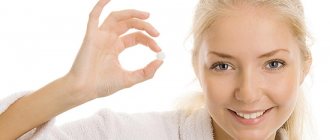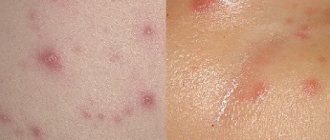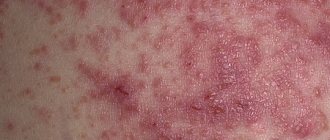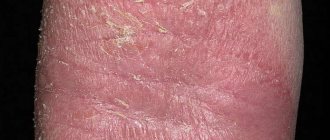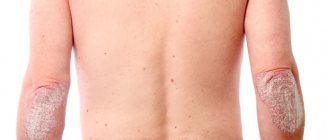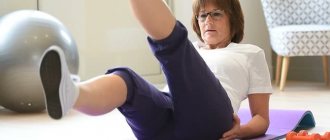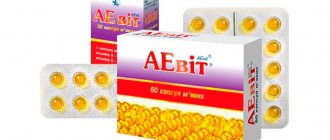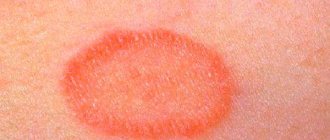Urticaria is a skin disease that produces pale pink blisters, similar to the appearance of a nettle burn. Discomfort reminiscent of itching from nettles is an accompanying symptom. This condition may be the result of an allergic reaction or dysfunction of internal organs. Pathology appears in pregnant women with toxicosis, in the presence of cancer or pathologies of the nervous system.
Causes and symptoms of urticaria
The acute form of urticaria occurs as a result of an allergic reaction. This condition can be provoked by:
- insect bites,
- Food,
- medications,
- infectious diseases.
Chronic urticaria indicates the presence of pathology in the body. Symptoms of the skin disease may be aggravated by exposure to cold, sunlight, heat, or vibrations.
Provoking factors also include stressful situations and nervous tension.
The characteristic signs of urticaria are blisters. Their outlines are clear or blurry, and their sizes can vary from 1 mm to several centimeters.
The acute form of the disease develops sharply. Chronic urticaria is accompanied by the appearance of mild symptoms that persist for an indefinite amount of time.
Hives blisters are very itchy. The feeling of itching and burning is constantly disturbing, so a person cannot sleep or rest normally. Against the background of this condition, neurological disorders may occur. To prevent this, you need to start treatment as quickly as possible.
To get rid of a chronic form of skin disease, you must first cure the underlying problem that has become a provoking factor. Typically, this manifestation is associated with disruption of the internal organs.
Why do adults and children get sick?
Children's bodies have not yet fully formed, so they need drugs with a gentle effect. But what ointment for hives is suitable for children? From the first days of life, babies are prescribed Zinc ointment and Zinocap, and starting from 4 weeks of age, they are prescribed drugs such as Nezulin and Fenistil-gel.
What does urticaria look like in children?
Hydrocortisone can be used in children under 2 years of age. But from the age of 6, children can also be prescribed hormonal ointments. Of course, there must be good reasons for this, since drugs containing hormones can not only help the baby cope with the disease, but also harm his body. To prevent anything like this from happening, parents should follow the doctor's instructions and not self-medicate.
Treatment of urticaria in children
There are quite a lot of medications for urticaria, both hormonal and without artificial hormones. But which of them is better to cope with their task in a particular clinical case - only the attending physician can determine. After all, even if a drug helped one patient, this does not mean that it will have the same effect on others.
The same symptoms of urticaria can be caused by completely different reasons. In this regard, it is called a polyetiological disease. Adults and children suffer from allergic diseases with approximately the same frequency.
- Allergic urticaria most often occurs after the bite of poisonous insects, in which a significant amount of allergen quickly enters the bloodstream. This mechanism is also relevant when consuming food products that induce allergies.
- The immune complex mechanism for the development of the disease is formed when antigen proteins come into contact with antibody proteins in the human body during treatment with drugs and the administration of therapeutic serums.
- In adults and children, pathological processes in the liver can interfere with one of the stages of histamine destruction, which is an activator of inflammation.
- The autoimmune form of urticaria develops when the body’s immune response to its own or foreign tissues.
Be sure to read:
Tips on how to treat heat rash in a newborn
The cause of chronic urticaria is considered to be chronic pathological processes of internal organs:
- diseases of the digestive system;
- bacterial infections;
- endocrine pathology;
- connective tissue diseases;
- lymphoproliferative changes;
- oncopathology.
Since chronic pathology occurs in adults and the elderly, the cause of childhood urticaria lies in food and medications.
Basic treatment methods
Antiallergic medications will help relieve the itching of urticaria. In the worst case, the situation can seriously worsen, and the disease develops into a severe form.
If the cause of the development of hives is an allergic reaction accompanied by burning and itching, then you can use special ointments. Among the variety of forms, there are hormonal and non-hormonal means for external use.
The use of hormonal and non-hormonal ointments
You can relieve itching from urticaria using modern ointments and sprays. When giving preference to non-hormonal drugs, you need to know that they are recommended for the treatment of mild forms of the disease in children and adults.
Distinctive features of hormonal drugs:
- fast action,
- good absorption,
- quick relief of itching.
Despite the fact that a small amount of hormones penetrates into the blood and there is no addiction, such a drug should only be prescribed by a doctor.
The most common ointments that relieve itching include:
- Flucinar,
- Celestoderm,
- Lorinden S,
- Prednisolone and hydrocortisone ointments.
For medicinal purposes, it is recommended to use hormonal drugs for no more than two weeks. In the worst case scenario, a person may experience side effects on the skin. As a result of non-compliance with recommendations, thinning of the skin and its atrophic changes may occur.
Patients with asthma should use Lorinden ointment with caution. This drug contains salicylic acid, which can cause an attack of suffocation.
Non-hormonal drugs are also very effective. Nezulin gel relieves itching well. In addition, it eliminates swelling and redness of the affected area of the skin. This remedy has an analgesic and cooling effect.
The best drugs are also considered:
- Fenistil gel. Its use eliminates itching and other symptoms of an allergic reaction. The affected skin cools and stops itching due to the action of the main component - dimethindene. This substance effectively relieves not only allergic symptoms, but also eliminates the manifestations of insect bites. The drug is often prescribed to children with chickenpox or rubella.
- Non-hormonal ointment Skin-up. It perfectly eliminates itching and also has a disinfectant and antibacterial effect. After treating the surface of the skin, the combed blisters become reliably protected from infection.
- Gistan cream also does not contain hormonal substances. The drug contains extracts of herbs such as string, calendula, euphorbia, birch buds, violet and lily of the valley oil.
- La-Cri cream copes well with skin inflammation. This remedy is effective even in the fight against allergic reactions, which cause itching and rash. The product contains avocado oil, licorice extract and string. In addition to these components, panthenol and bisabolol can also be found in the list of active substances.
Symptoms of the disease
Skin blisters are the main and most striking symptom of urticaria. Visually, they resemble skin changes caused by bites. Red spots protruding above the skin, in severe cases, merge into giant formations.
A distinctive feature of urticaria rashes is the reversibility of the process. No matter how large the blisters are, after recovery they disappear, leaving no marks, pigmentation or scars. During repeated exacerbation, the location of the blisters does not coincide with the previous one.
Symptoms of acute urticaria:
- sudden appearance of rash and itching;
- the majority of blisters are of regular round shape;
- when the complexes merge, the blisters have an oblong irregular shape;
- general weakness appears;
- feverish condition;
- rashes appear on the arms, legs, palms and torso, less often on the mucous membranes;
- digestive disorders.
Symptoms of persistent papular form:
- persistent papular rash;
- acanthosis (thickening of the epidermis due to an increase in the number of cells of the spinous layer);
- hyperkeratosis (thickening of the epidermal layer);
- the appearance of brownish nodules in the area of the flexor surfaces of the limbs;
In the chronic form of the disease, symptoms appear periodically, and the rash is less intense. During the period of exacerbation, symptoms of intoxication appear:
- headache;
- aching joints;
- vomiting or nausea;
- dyspepsia.
The patient's serious condition causes sleep and mental disorders.
Urgent action for urticaria
To quickly eliminate the symptom of rash, itching, redness and swelling of the skin due to urticaria, you need to follow these recommendations:
- remove the allergen,
- use a laxative, for example, special tea, decoction or magnesia,
- do a cleansing enema,
- take activated carbon in accordance with the age dosage,
- use anti-allergy medications (they should be chosen according to doctor’s recommendations),
- affected areas of the skin should be wiped with an alcohol solution,
- Hormonal ointments can be used as an external treatment,
- you need to adhere to dietary nutrition; if the inflammation is acute, it is better to eat exclusively plant foods.
Diagnostics
Due to the lack of specific methods for diagnosing urticaria, much attention is paid to examining and interviewing patients. Additionally, they need consultation with an allergist, immunologist and dermatologist.
Allergens are identified using skin tests. After taking a history and physical examination, the degree of disease activity is assessed.
Be sure to read:
How to treat bedsores on the heels
To differentiate the type of urticaria, provocative tests are performed:
- mechanical effects on the skin confirm dermographism;
- solar urticaria is diagnosed by phototest;
- aquaform is confirmed by a water compress;
- The Duncan test (applying ice cubes) helps diagnose cold urticaria.
Ultrasound and magnetic resonance diagnostics are used only to determine concomitant diseases.
Traditional medicine
Traditional medicine recipes are not used to treat allergy symptoms. With the help of such drugs you can only alleviate the symptoms. In this case, it concerns the elimination of itching.
Severe itching on the body due to hives can be reduced with the following medications:
- A decoction is prepared from nettle leaves and water, which, after cooling, must be strained and poured into a more suitable container. The affected areas of the skin should be washed several times a day for 3 days.
- You can make a bath out of the string. The decoction is also prepared for bathing newborns, so it does not cause any harm, it only soothes the skin and eliminates damage to it. The herb of this plant must first be brewed in a large amount of water. You should soak in a warm bath for 10 minutes. The herb can remove manifestations of the inflammatory and allergic process on the skin.
- A decoction can be prepared from a mixture of herbs. For this you will need: string, St. John's wort, celandine, sage, valerian root and chamomile flowers. Mix everything, add cold water and bring to a boil. The process should take approximately 10 minutes. After infusing and filtering the product, you need to add it to the bath. It is important to carry out this treatment procedure once every 3 days for 3 weeks.
- Celery juice can be an addition to drug treatment. It should be taken 1 teaspoon before meals.
- A good and simple remedy is raw potatoes. It must first be cut into slices or grated on a fine grater. Potatoes are applied directly to the blisters. With this procedure you can quickly relieve itching and swelling.
Giving preference to traditional medicine, it is worth understanding that it should be used in combination with traditional treatment. If necessary, the doctor will recommend the most effective method that will help in a particular situation.
If you do not take any action on hives, symptoms of an allergic attack may occur. If they are present, you should immediately call an ambulance.
Specifics of treatment according to the type of origin of urticaria
Each type of urticaria is treated with separate medications, and each has its own specific treatment.
This type of pathological process is treated in the same way as any other allergic reaction. The first step is to stop any contact with provoking factors. As drug therapy, doctors use antihistamine drugs, these include: Cetrin, Loratadine, Diphenhydramine.
Physical
Physical urticaria cannot be confused with other types; the whole point is that white blisters appear on the patient’s body, similar to those that appear upon contact with nettles. Delayed treatment can lead to serious health problems, so at the first symptoms you should immediately consult a doctor.
Treatment of physical urticaria is quite difficult and requires a lot of effort on the part of specialists and, of course, the patient himself. In this case, doctors prescribe drugs of the glucocorticosteroid group (Methylprednisolone). It is worth noting that after completing a course of therapy, recovery does not occur immediately, because colored scars remain in place of the former blisters, which disappear over time.
Cholinergic
This type of urticaria occurs as a result of the fact that the human immune system reacts very sharply to the mediator acetylcholine. Treatment of this pathological process is carried out with local therapy: doctors prescribe ointments and creams, which include belladonna and atropine. It is these two components that inhibit the activity of acetylcholine. In this case, there is no standard treatment: the doctor selects individual treatment for each patient.
Contact
In case of contact urticaria, it is very important to completely eliminate contact with the allergen. In this situation, doctors prescribe patients to drink plenty of fluids so that all provoking elements leave the body. In more severe cases, it is better to drink something laxative: it can be laxative tea or a medicinal solution.
If you have contact urticaria, you must strictly follow proper nutrition. The same actions are suitable for patients diagnosed with mechanical urticaria.
Hormonal remedies for urticaria
In some cases, medications containing adrenal hormones (glucocorticosteroids) are recommended for the treatment of urticaria.
They have more powerful anti-inflammatory and antipruritic properties.
Restrictions on the use of hormone-containing ointments:
- Infections of a bacterial, fungal, bacterial or viral nature (herpes, syphilis, tuberculosis, chicken pox, mycoses, etc.);
- Open wounds;
- New growths on the skin or suspicions of them;
- Vulgar and rosacea;
- Breastfeeding and pregnancy;
- Post-vaccination reactions on the skin;
- Intolerance to any ingredient included in the medication.
They are used in short courses (no more than 2 weeks) to avoid systemic side effects affecting the hormonal regulation of the body.
The amount of ointment and the number of applications should be minimal.
Flucinar
Polish ointment and gel based on fluocinolone acetonide.
A powerful remedy that acts on all mechanisms that cause urticaria:
- Reduces the synthesis of inflammatory inducers - prostaglandins and leukotrienes;
- Suppresses the immune response in the area of application (inhibits the synthesis of interferon);
- Stabilizes the structure of cell membranes and intracellular organelles;
- Reduces inflammation and area of rashes;
- Reduces exudation and redness;
- Quickly eliminates itching.
Preventive measures
To avoid relapses, the patient must strictly follow a diet and prevent allergens from re-entering the body. Medicines are used only as prescribed by a doctor and under strict supervision. It is imperative to fully treat diseases that can become chronic.
On hot days, protect the skin from excessive radiation. In cold weather, do not allow the body to become hypothermic.
PS Please also leave your feedback on the treatment of urticaria with the help of medications.
- Urticaria on milk in a child
- Seborrheic dermatitis on the face - treatment, ointments and creams
- Gelatin mask against blackheads
- Urticaria in children - causes, symptoms, diagnosis and treatment
What are the types of ointments and when to use them?
It is difficult to confuse rashes with urticaria with other dermatoses, since urticaria is similar to a nettle burn (hence the name). If you doubt the diagnosis, it is better not to self-medicate and immediately consult a dermatologist.
Preparations for urticaria for external use are divided into:
Gel or cream often means a lighter structure and a water base. The ointment contains fats and oils. But there are no differences in the active substance, so the form of release of the drug does not affect its effectiveness.
General requirements for use
- Any ointment should be applied directly to the affected areas of the skin. When using steroid-based products, it is necessary to protect healthy skin as much as possible from contact with the drug, since the larger the area of application, the greater the amount of hormones that will enter the blood.
- Apply the ointment in a thin layer and wait until completely absorbed. Fatty ointments are not completely absorbed, so 15-20 minutes after application, excess product can be removed with a napkin.
- The frequency of application of the product must be done strictly according to the instructions, since more does not mean better. In case of overdose, there is a high risk of developing side effects such as burning, peeling, dry skin and allergic rash.
Hormonal agents
Hormonal ointments contain glucocorticosteroids - hormones that can relieve inflammation and swelling, quickly eliminate itching and soothe the skin.
The main advantage of this group of products is speed of action and effectiveness.
But there are a number of negative points:
- Hormonal ointments have a large number of side effects, so they cannot be used for a long time (no more than 5 days).
- The use of such drugs in childhood, pregnancy and lactation is contraindicated. Sometimes children are prescribed steroid creams, but they must be used strictly under the supervision of medical personnel.
- These drugs are addictive, and if the dosage or timing of use is violated, withdrawal syndrome may develop (dermatosis manifests itself with renewed vigor after the end of using the ointment).
- With prolonged use, adrenal function deteriorates, which leads to hormonal imbalances.
- In order to minimize the risk of absorption of a large volume of glucocorticosteroids into the blood, hormonal ointments should not be used if there are wounds, scratches, or ulcers on the skin at the sites of application.
Traditional ways to get rid of itching
Many herbs and natural ingredients have natural anti-inflammatory effects. If you use them for home treatment, you can remove the itching from hives and speed up recovery. It is important to understand that home remedies do not replace drug treatment. This circumstance is associated with the effect of folk remedies - it can be anti-inflammatory and soothing, but antihistamines or hormonal drugs cannot be replaced with their help.
The best herbal remedies for relieving itching are chamomile and string. The reason for their popularity is their high efficiency and almost complete absence of contraindications. Baths with decoctions of these plants are even used to treat infants.
Lotions with nettle decoction work well. This plant has an anti-inflammatory effect.
If we’re not talking about herbs, but about other natural ingredients that can relieve itching, then it’s worth mentioning oatmeal. Porridge from this cereal is used to create lotions, as it relieves itching and reduces swelling.
There are medications that are not used by doctors to treat hives, but are used at home to relieve the condition. We are talking about sedatives like valerian tincture. As with any drug, you need to be careful not to overdose. If you take the product in accordance with the instructions, the calming effect will make the body less sensitive to itching.
When you have doubts about any of the home treatments suggested by others, be sure to consult your doctor about its use. As a rule, specialists have nothing against harmless methods, but prohibit the use of dubious methods of treatment.
First aid medicines
Medical care for adults with nettle fever complicated by angioedema or anaphylactic shock is provided with the use of injection medications:
- Adrenaline 0.5% - the medicine is administered when the first symptoms of difficulty breathing appear (1 ml intramuscularly once). If there is no result, then after 5-10 minutes the injection is given again. The medicine helps to narrow blood vessels, prevents elastic collapse of their walls, which normalizes blood pressure and restores blood circulation. An injection of adrenaline normalizes the functioning of the heart muscle, which worsens during anaphylaxis, and relieves spasm of the respiratory tract, thereby ensuring free delivery of oxygen to the lungs.
- Diphenhydramine 1% is an effective remedy for urticaria of allergic origin and belongs to the second-line drugs (reserve drugs). Used for first aid and subsequent treatment. The injection is administered intramuscularly every 4-6 hours, 1 ml. The medicine relieves allergy symptoms on the body and calms the nervous system.
- Prednisolone is a hormonal drug prescribed to adult patients when anaphylaxis occurs. The injection is given into the muscles of the upper thigh; if the allergic reaction worsens, it is injected into a vein every 4 hours. The drug relieves allergies and has an anti-shock effect.
If the necessary medications are not in the home medicine cabinet or there is no one to give the injection, then an adult patient can be given 2-3 tablets of diphenhydramine and prednisolone ointment applied to the skin before the ambulance arrives. The doctor prescribes other oral medications for urticaria complicated by allergic swelling after examining the patient.
It is very important for a person with Quincke's edema to receive immediate assistance, otherwise everything could end in death.
So let's look at the first aid instructions. It is necessary to exclude factors that provoke allergies. Lay the person on the bed and try to cheer him up (feelings of panic only makes the situation worse). Open access to air (the situation worsens indoors). Cold compresses can be applied to relieve itching and swelling.
Before the ambulance team arrives, it is necessary to give the patient as much water as possible and some kind of sorbent to cleanse the body of allergens (activated carbon, polysorb, smecta). Give an antihistamine (Suprastin helps best). To prevent swelling from spreading, you need to immerse the patient's feet in hot water.
What are the types of ointments and when to use them?
It is difficult to confuse rashes with urticaria with other dermatoses, since urticaria is similar to a nettle burn (hence the name). If you doubt the diagnosis, it is better not to self-medicate and immediately consult a dermatologist.
Preparations for urticaria for external use are divided into:
Gel or cream often means a lighter structure and a water base. The ointment contains fats and oils. But there are no differences in the active substance, so the form of release of the drug does not affect its effectiveness.
General requirements for use
- Any ointment should be applied directly to the affected areas of the skin. When using steroid-based products, it is necessary to protect healthy skin as much as possible from contact with the drug, since the larger the area of application, the greater the amount of hormones that will enter the blood.
- Apply the ointment in a thin layer and wait until completely absorbed. Fatty ointments are not completely absorbed, so 15-20 minutes after application, excess product can be removed with a napkin.
- The frequency of application of the product must be done strictly according to the instructions, since more does not mean better. In case of overdose, there is a high risk of developing side effects such as burning, peeling, dry skin and allergic rash.
